Page 2 of 3
Gear Conversion
Well, this one is really quite horrible. I don't know when it was done, but it certainly
was no earlier than the mid 1970s, because that's when the guitar was made. It takes
a bit of doing to remember that we really have no way of knowing the motivation or
reason for the work. It's still important to recognize that we don't know why, and
since we can't go back, we must forgive it.
We often decry the loss of "originality" when replacing tuning machines,
but such replacement usually at least results in an instrument that works better.
This one, with the increased downward pressure on the nut, actually doesn't work
well at all:

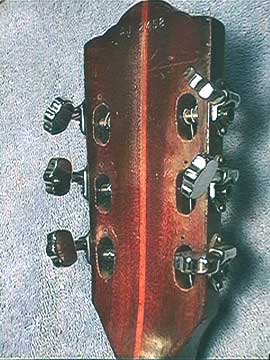
I find this modification somewhat less forgivable than those coversions we see which
were made during the "dark ages" of low guitar popularity. Grover Rotomatic
or Schaller tuners could be had for less than 25 bucks, would have worked well, and
would have been easy to install.
Faux Wood Grain
I have to show you two more pictures of this fine old archtop guitar. It's really
quite a piece of work. The top and back are made of fine solid birdseye maple. But
check out the wonderful finish:
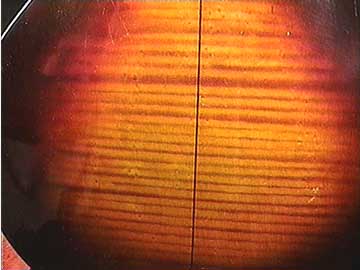
Here the back is spray painted to simulate curly fiddle back maple grain. It's not
a bad job for a production guitar; it's just a shame that they didn't simply let
the birdseyes carry the show!
The top is even more amazing. Same tightly figured birdseye maple here, but this
time they've painted it to look like spruce:
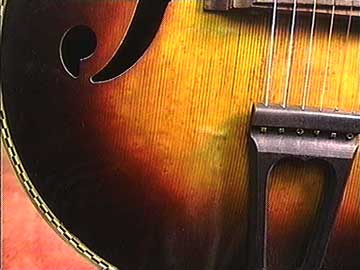
Gibson Mandolin Beautification Project
This is a classic Gibson style A mandolin from about 1915:
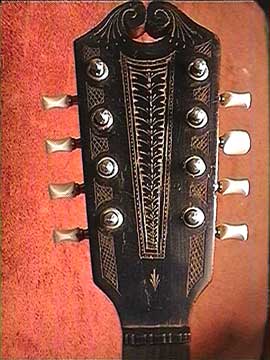
And, it has been richly incised to create a European flavor. Unfortunately, it's
not the sort of work that can be easily undone.
Conversions
Here are three skeletons from my closet:
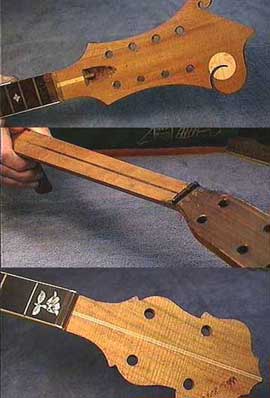
At the top, it's a neck from a 1930s Gibson F-7. MOre than twenty years ago
I was asked to convert this instrument from the F-7 short neck to the F-5 long
neck style. Most everyone would agree that the conversion successfully upgraded
the instrument to a much more playable and better sounding mandolin. These days,
however, we all agree that the collector value is greater than the "musical
value" so it's not a wise thing to do.
The middle neck was one I removed from a Martin OM-18P, a plectrum 4-string
guitar. I reshaped and transplanted a 1940s vintage D-18 neck onto that instrument,
converting it to a regular six-string guitar.
Both of these jobs were done a long time ago and represented the current state
of the art thinking at the time, so I feel I have nothing to apologize for.
These necks do serve as a reminder of days past.
The bottom neck is a tenor banjo neck from which I salvaged the peghead overlay
in order to make a five string replica neck. I acquired the neck, broken off
at the heel, without the rest of the banjo. In 1974, I bandsawed off the peghead
veneer as I had on other occasions to lend a bit of "authenticity"
to my replica neck. That was at the time considered the proper thing to do,
both to save effort in inlay work, and to capture a bit of originality. Most
of the necks we salvaged in this way in the 1960s were not damaged, they were
just four string necks, and not considered valuable at the time. These days,
it's considered more appropriate to reproduce the peghead inlay, and keep the
tenor neck intact. It seems obvious now, but it didn't then.
If you'd like to see the results of the five string conversion, click here for
some photos of the Washburn banjo, which I still have after 25 years.
And, here's another old Washburn banjo. This one dates from about 1900, and
appears to be a short neck tenor, with an inlay at an unusual position, namely
the second fret:
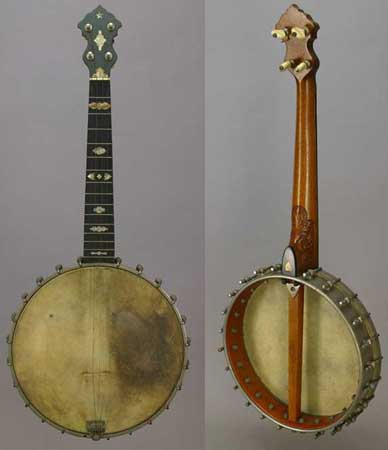
A closer examination reveals that it was originally an elegant open back five
string banjo that was skillfully cut down to make it into a short 15-fret tenor
at a time (probably the 1920s) when the short neck tenor was a popular melody
instrument.

No trace of the original fifth peg remains, and that second fret inlay was originally
at the seventh fret. The only thing I know for sure is we have no place asking,
"What were they thinking?" or "How could they have done
that?" That was then, this is now. . .
More
1
2
3
Back to Index Page







